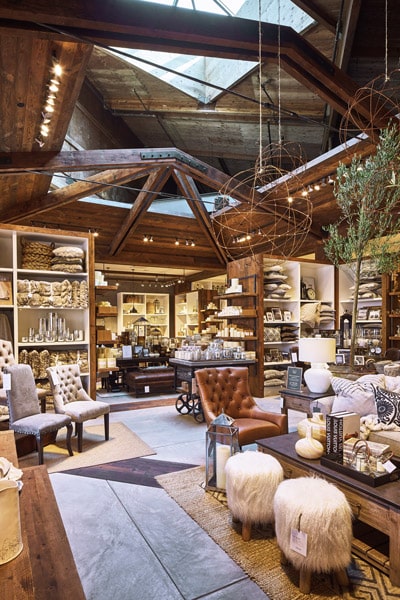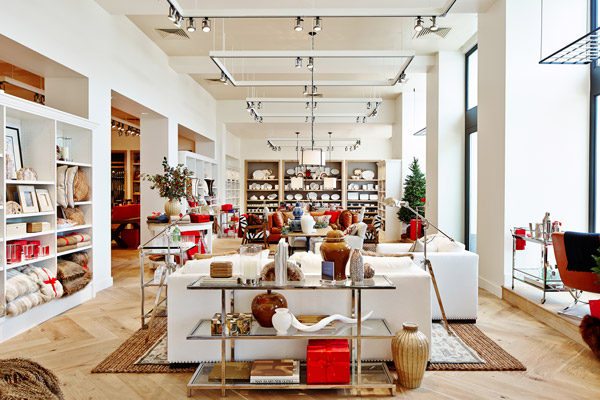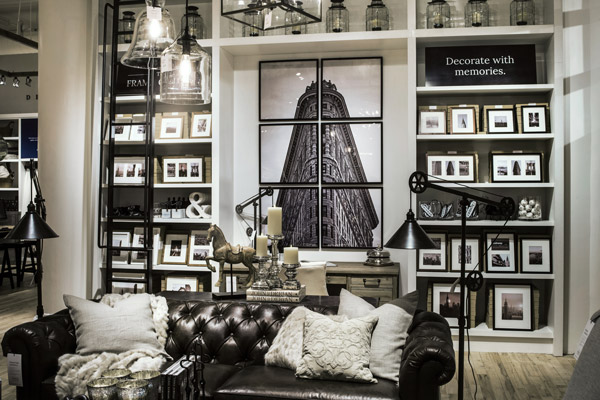How has Williams Sonoma managed to not only stay afloat, but increase its market share, in the face of a rapidly changing retail marketplace? Theresa Joy Hannig, director of store design, says the answer lies with something elemental: the five senses.
“Our stores are so much more than a store, and they invigorate the senses more than other retailers can,” Hannig explains. “In a Pottery Barn, you can hear the sound of an instructor teaching you how to make pressed flowers, and then in a Williams Sonoma, you have the smells of the cooking, and you can run your hand over all of our amazing textiles. It’s very visceral.”
 Also visceral is Hannig’s passion for her work, which is contagious. Her love of architecture and design started early. “I think if you asked me what I wanted to be when I grew up when I was five, I said ‘architect,’” she says. “I don’t remember not being interested in architecture. I’ve always loved buildings and creating experiences for people.” Her lifelong love of buildings led her to study architecture at UC Berkeley.
Also visceral is Hannig’s passion for her work, which is contagious. Her love of architecture and design started early. “I think if you asked me what I wanted to be when I grew up when I was five, I said ‘architect,’” she says. “I don’t remember not being interested in architecture. I’ve always loved buildings and creating experiences for people.” Her lifelong love of buildings led her to study architecture at UC Berkeley.
While Hannig didn’t plan on going into retail design when she entered Berkeley, she says that she couldn’t have picked a better place for her current role. “Berkeley as an institution encourages students to question norms, and seek a spirit of newness and innovation, and those are all things you need in the competitive retail space,” she explains. “The architecture program specifically is very process-oriented and research-based. Every aspect of your design has to be rationalized, analyzed, and have a purpose, which is perfect training for retail.”
During her junior year of college, a professor forwarded an application for a store design internship at Williams Sonoma to Hannig, remembering that she liked to cook. Hannig was offered the role almost immediately, and she’s been with the company ever since, coming back to work over winter break during her senior year and immediately after graduation.
Since her graduation, Hannig has risen through the company with impressive speed. In her first role after graduating, she opened a series of Pottery Barn Teen pop-up stores across the country. Then, a position in construction opened up, and Hannig’s supervisor encouraged her to take it as a learning experience. “I actually took a pay cut to do it, but it was completely worth it,” she says. “It helps me every day in my job now. I’m more efficient with costs and a lot more aware of what I can design.”

After spending a year in construction, Hannig stepped into an open role in design. In her current role, she’s responsible for Williams Sonoma and Williams Sonoma Home, all of the Pottery Barn imprints, and Rejuvenation. Each brand has its own distinctive look, down to the materials that are most prominent in the stores. “For Pottery Barn, it’s all about the wood,” she says, whereas Williams Sonoma stores are more focused on “leveraging the architecture” that already exists. What unites all of Williams Sonoma’s brands is a focus on local design, rather than a big-box retail template. “We really embrace the architecture of the building, and we think about what that area is known for and get local, salvaged materials. Our customers really love this—they love the story of it,” she says.
Hannig believes that storytelling is an integral aspect of the customer’s experience and another key factor of Williams Sonoma’s ongoing success in the physical retail space. “I think in the past, people went to the store to get information, like ‘How much does this cost?’” she says. “But now, because there are so many choices and so much information available, that I think the differentiator in retail is the emotional experience—like for us, you can look at a beautifully set table in a store and imagine hosting all of your family over for dinner.”
 When it comes to ecommerce, Hannig rejects conventional wisdom that Millennials are solely responsible for the shift towards online shopping. “Everyone is changing the way they’re shopping,” she says. “We all love being able to look things up online, compare prices, read reviews, and find the best thing.” But this isn’t a negative for Williams Sonoma’s retail stores—quite the opposite, in fact. “Our online and retail spaces are completely integrated with each other,” she says. “The great thing about home goods is they’re so dimensional, physical, and hands-on, and I think that’s our differentiator.”
When it comes to ecommerce, Hannig rejects conventional wisdom that Millennials are solely responsible for the shift towards online shopping. “Everyone is changing the way they’re shopping,” she says. “We all love being able to look things up online, compare prices, read reviews, and find the best thing.” But this isn’t a negative for Williams Sonoma’s retail stores—quite the opposite, in fact. “Our online and retail spaces are completely integrated with each other,” she says. “The great thing about home goods is they’re so dimensional, physical, and hands-on, and I think that’s our differentiator.”
That differentiator has meant continuing success and expansion for the brand; Hannig recently helped bring flagship West Elm, Pottery Barn, and Pottery Barn Kids stores to Seoul, South Korea. Bringing a distinctly American brand overseas means bridging cultural differences about design and construction, and Hannig had to balance respecting local culture while protecting our brand aesthetic. The project was a success, and the stores opened in July 2017.
Hannig was also instrumental in the redesigning the store aesthetic of both Pottery Barn and Williams Sonoma. “We talked a lot about putting the ‘barn’ back in Pottery Barn, with wood timber ceilings, and we used a local blacksmith to make all of the steel details,” she says. The redesign features all-new interior fixtures, which helps “make the product look like it’s in a gallery and gives it an elevated feeling.” The Williams Sonoma redesign involved updating the classic, French-inspired appearance that harkened back to the original location. Hannig and her team took the store aesthetic in a much more modern direction, giving it the feel of an aspirational industrial kitchen.
Conceptually, Hannig wanted both of these redesigns to strike the perfect balance between aspirational and comfortable. “I want people to both feel at home with the brand, and to feel at home in the literal sense. I’m so proud that design language can really make so many different people feel at home in different places,” she says.

Looking to the future, Hannig and her team are working closely with Williams Sonoma’s real estate teams to bring their stores to new, vibrant locations. “We want to be in places where people are already spending their time and make them feel like they want to spend time with us, too,” she says. “I love using the design of these physical spaces to leverage these legacy brands—using the brand’s sense of quality and trust, but making it relevant and accessible.”
Hannig’s colleagues are impressed by her ability to do just that. “Hinged on a solid architectural and design foundation, Theresa Joy’s passion for taking something old and breathing fresh life into it is exciting to watch,” says Melissa Saltsgaver of Signtech. “As a part of her extended team, we have the pleasure of providing signage and specialty pieces to help her tell the story.”
Hannig’s ability to balance seemingly contradictory qualities in her work—historic, but modern; aspirational, but accessible; creative, but practical—is seriously impressive, and so is her obvious investment in the company with which she’s spent the last six years. She credits her fantastic team with helping her learn and grow throughout her time at the company, citing Bud Cope, executive vice president and chief real estate development officer, as one particularly important mentor.
Another type of team at Williams Sonoma is also instrumental to Hannig’s success: the in-store sales team. “My work would be nothing without what the store teams do to bring it to life. The space is worthless if there’s not someone to make the customer feel at home,” she says. “Williams Sonoma has a reputation of really caring about and serving the customer. I think that’s what will position us as technology changes: making our technology serve the customer; not leading with technology, but leading with listening. That’s what I see for Williams Sonoma.”
Photos: Gillian Fry, Courtesy of Williams-Sonoma


